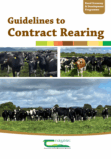
Guidelines To Contract Rearing
This booklet, Guidelines to Contract Rearing is one of a series of booklets produced by the Farm Management Unit in Teagasc on Collaborative Farming Options. Other booklets in the series include: Guidelines to Forming a Registered Farm Partnership and Guidelines to Long-term land leasing. Contract rearing involves the movement of livestock from the owner’s farm […]
By Farm Management Unit in Teagasc
Download Publication (PDF)
This booklet, Guidelines to Contract Rearing is one of a series of booklets produced by the Farm Management Unit in Teagasc on Collaborative Farming Options. Other booklets in the series include: Guidelines to Forming a Registered Farm Partnership and Guidelines to Long-term land leasing.
Contract rearing involves the movement of livestock from the owner’s farm for rearing on contract by another farmer on their holding. In the majority of cases it involves the rearing of dairy replacement heifers but there are also examples where beef livestock and store lambs are contract reared. Reductions in organic nitrogen stocking rate allowances, difficulty sourcing land to lease, high land rental costs and labour shortages are some of the reasons farmers might consider the option of having their livestock contract reared by another farmer. On the other side of the arrangement, for the contract rearer, not having to make the financial outlay to purchase stock, a regular income throughout the year and a reduction in the financial risks associated with other enterprises may make contemplating this enterprise an appealing option.
The purpose of this booklet is to determine if contract rearing is a suitable option for particular farmers, to guide prospective contract rearing partners through the process of finding a suitable rearing partner, outlining what should be covered in the contract rearing agreement, setting realistic targets and determining costs that are fair to both sides of the arrangement. For any agreement to last long term, it needs to be win win for both parties. This arrangement should be built on mutual respect and trust that has been earned. The agreement can be tailored to suit both parties and therefore no two contract rearing arrangements need to be the same. There are many examples of successful rearing agreements in place that have been running for several years – the key to a successful agreement is to pair with a suitable partner, ensure the arrangements is of benefit to both parties and maintain honesty and respect at all times.
